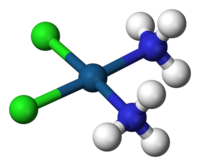
Photo from wikipedia
A new alternative for accessing metal–ligand containing polymers via coordination insertion copolymerization of 1-hexene and ligated α-olefin is disclosed herein. To overcome the deactivation of active species by heteroatoms, the… Click to show full abstract
A new alternative for accessing metal–ligand containing polymers via coordination insertion copolymerization of 1-hexene and ligated α-olefin is disclosed herein. To overcome the deactivation of active species by heteroatoms, the present study employed a less electrophilic late transition metal complex, and efficient copolymerizations were successfully achieved, giving rise to poly(1-hexene) elastomers containing a benzimidazolyl quinoline ligand up to 5.77%. Moreover, the copolymerization displayed a living nature, demonstrating a capability of control over the molecular weights and molecular weight distribution. Coordination of the obtained ligated poly(1-hexene) elastomers with metal ions produced polymer networks with the ligand–metal complexes as crosslinkers and thus led to a significant enhancement of the mechanical properties of the resultant materials.
Journal Title: Polymer Chemistry
Year Published: 2020
Link to full text (if available)
Share on Social Media: Sign Up to like & get
recommendations!